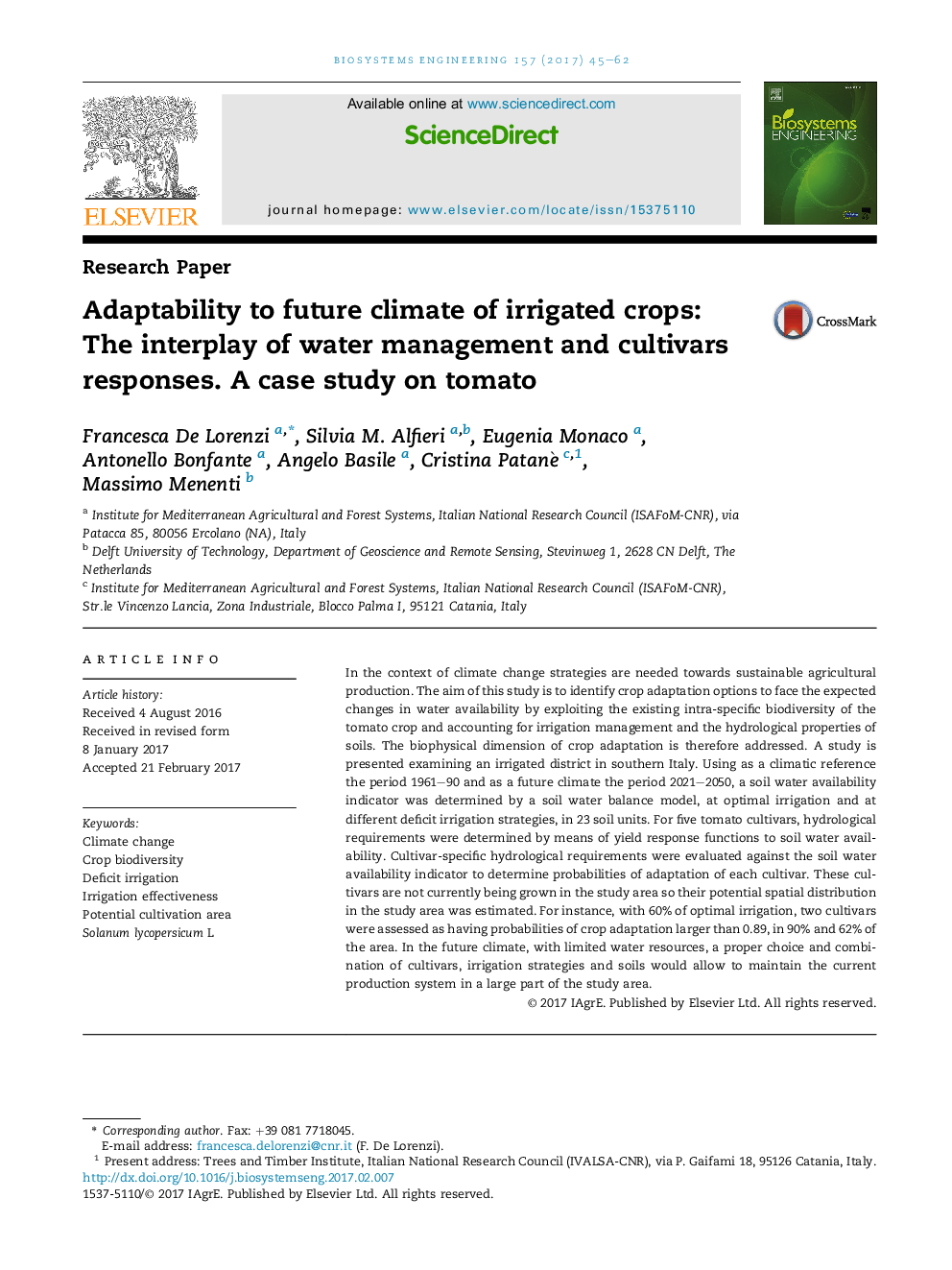| کد مقاله | کد نشریه | سال انتشار | مقاله انگلیسی | نسخه تمام متن |
|---|---|---|---|---|
| 5471884 | 1519504 | 2017 | 18 صفحه PDF | دانلود رایگان |
عنوان انگلیسی مقاله ISI
Adaptability to future climate of irrigated crops: The interplay of water management and cultivars responses. A case study on tomato
ترجمه فارسی عنوان
سازگاری با آب و هوای آینده محصولات آبیاری: تعامل بین مدیریت آب و واکنش ارقام. یک مطالعه موردی در گوجه فرنگی
دانلود مقاله + سفارش ترجمه
دانلود مقاله ISI انگلیسی
رایگان برای ایرانیان
کلمات کلیدی
ترجمه چکیده
در زمینه تغییرات اقلیمی، استراتژی های لازم برای تولید محصولات کشاورزی پایدار مورد نیاز است. هدف از این مطالعه شناسایی گزینه های انطباق محصول برای مقابله با تغییرات مورد انتظار در دسترس بودن آب با بهره گیری از تنوع زیستی موجود در موجودات گوجه فرنگی و حسابداری برای مدیریت آبیاری و ویژگی های هیدرولوژیکی خاک است. بعد بیوفیزیکی سازگاری با محصول مطرح می شود. یک مطالعه برای بررسی یک منطقه آبیاری در جنوب ایتالیا ارائه شده است. با استفاده از مرجع اقلیمی دوره 1961-90 و به عنوان آب و هوای آینده در دوره 2021-2050، شاخص آبگیری آب خاک با استفاده از مدل تعادل آب خاک، آبیاری مطلوب و استراتژی های آبیاری کمیاب در 23 واحد خاک تعیین شد. برای پنج رقم گوجه فرنگی، الزامات هیدرولوژیکی با استفاده از عملکرد عملکرد پاسخ به قابلیت دسترسی به آب خاک تعیین شد. الزامات هیدرولوژیکی خاص ارقام به منظور تعیین احتمال انطباق هر رقم، براساس شاخص قابلیت دسترسی آب خاک مورد ارزیابی قرار گرفت. این ارقام در حال حاضر در منطقه مورد مطالعه رشد نمی کنند، بنابراین توزیع پتانسیل فضایی آنها در منطقه مورد مطالعه تخمین زده می شود. به عنوان مثال، با 60٪ از آبیاری مطلوب، دو رقم به عنوان احتمال انطباق محصول بیشتر از 0.89، در 90٪ و 62٪ از منطقه مورد ارزیابی قرار گرفتند. در شرایط آب و هوایی آینده، با منابع آب محدود، انتخاب مناسب و ترکیبی از ارقام، استراتژی های آبیاری و خاک، به حفظ سیستم تولید فعلی در بخش بزرگی از منطقه مطالعه امکان می دهد.
موضوعات مرتبط
مهندسی و علوم پایه
سایر رشته های مهندسی
کنترل و سیستم های مهندسی
چکیده انگلیسی
In the context of climate change strategies are needed towards sustainable agricultural production. The aim of this study is to identify crop adaptation options to face the expected changes in water availability by exploiting the existing intra-specific biodiversity of the tomato crop and accounting for irrigation management and the hydrological properties of soils. The biophysical dimension of crop adaptation is therefore addressed. A study is presented examining an irrigated district in southern Italy. Using as a climatic reference the period 1961-90 and as a future climate the period 2021-2050, a soil water availability indicator was determined by a soil water balance model, at optimal irrigation and at different deficit irrigation strategies, in 23 soil units. For five tomato cultivars, hydrological requirements were determined by means of yield response functions to soil water availability. Cultivar-specific hydrological requirements were evaluated against the soil water availability indicator to determine probabilities of adaptation of each cultivar. These cultivars are not currently being grown in the study area so their potential spatial distribution in the study area was estimated. For instance, with 60% of optimal irrigation, two cultivars were assessed as having probabilities of crop adaptation larger than 0.89, in 90% and 62% of the area. In the future climate, with limited water resources, a proper choice and combination of cultivars, irrigation strategies and soils would allow to maintain the current production system in a large part of the study area.
ناشر
Database: Elsevier - ScienceDirect (ساینس دایرکت)
Journal: Biosystems Engineering - Volume 157, May 2017, Pages 45-62
Journal: Biosystems Engineering - Volume 157, May 2017, Pages 45-62
نویسندگان
Francesca De Lorenzi, Silvia M. Alfieri, Eugenia Monaco, Antonello Bonfante, Angelo Basile, Cristina Patanè, Massimo Menenti,
